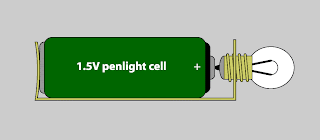Section 01: Measuring Electric Current (විද්යුත් ධාරාව මැනීම)
Electric current is "a flow of charged particles (plus charge or minus charge)". "Ammeter"
is the measuring device for measuring electric current. To measure the
current (charged particle flow), complete flow must go through the
current measuring device, Ammeter. Now it is clear ammeter must connect Series to measuring circuit.
විද්යුත්
ධාරවක් යනු "විද්යුත් අරෝපණ (ධන හා සෘණ වශයෙන් අරෝපණ දෙවර්ගයක් පවතී)
ප්රවාහයක් සන්නායකයක් දිගේ ගලා යෑමයි". විද්යුත් ධාරාව මැනීමට "ඇමීටර"
භාවිතා කරනු ලබයි. පරිපථයේ ගලා යන විද්යුත් ධාරාව නිවරදිව මැනීමට නම් එම
සම්පූර්ණ ධාරාවම ඇමීටරය හරහා ගමන් කළ යුතු බව ඉතා පැහැදිලි කරුණකි. එබවින්
සෑම විටම ඇමීටරය පරිපථයට ශ්රේණිගතව (series) සම්බන්ධ කල යුතුමය.
For Ammeters also there are two types exists according to construction.
ක්රීයාකාරීත්වය අනුව ඇමීටර වගර් දෙකකි.
1. Analog ammeters (ප්රතිසම ඇමීටර)
2. Digital ammeters (සංබ්යාක ඇමීටර)
Most
of the practical cases we have to deal with high voltages and high
currents. It is extremely dangerous to work with high voltages and high
currents and also difficult to handle by measuring devices. To avoid
this situation Voltage Transformers (VT) and Current Transformers(CT)
are commonly use in industry. We will discuss about VTs and CTs in
another post.
ප්රායෝගික භාවිතයේදි බොහෝ විට දක්නට ලැබෙන්නෙ අධිසැර වෝල්ටීයතාවයන් සහ අධිසැර විද්යුත් ධාරාවන්ය. අධිසැර වෝල්ටීයතාවයන් ඉතාමත් අනතුරුදායක වන අතර මැනුම් උපකරණ වලින් මැනීමටද නොහැක. මෙම අපහසුතාවයන් මගහරවැ ගැන්මට වෝල්ටීයතා පරිනාමක (VT) සහ ධාරා පරිනාමක (CT) භාවිතා කරනු ලැබේ. ඉදිරි ලිපියකින් මෙම පරිනාමක ගැන වැඩිදුරට සාකච්ඡා කරනු ලැබේ.
Next Post - Coming Soon
EE L04: Electrical Resistance (විද්යුත් ප්රතිරෝධය)






